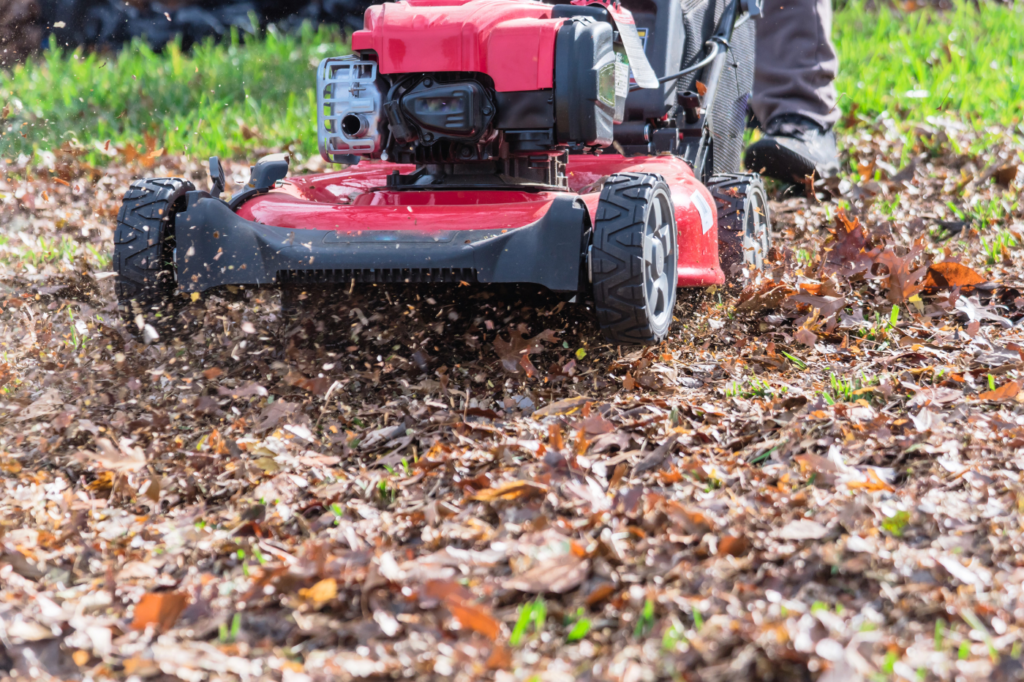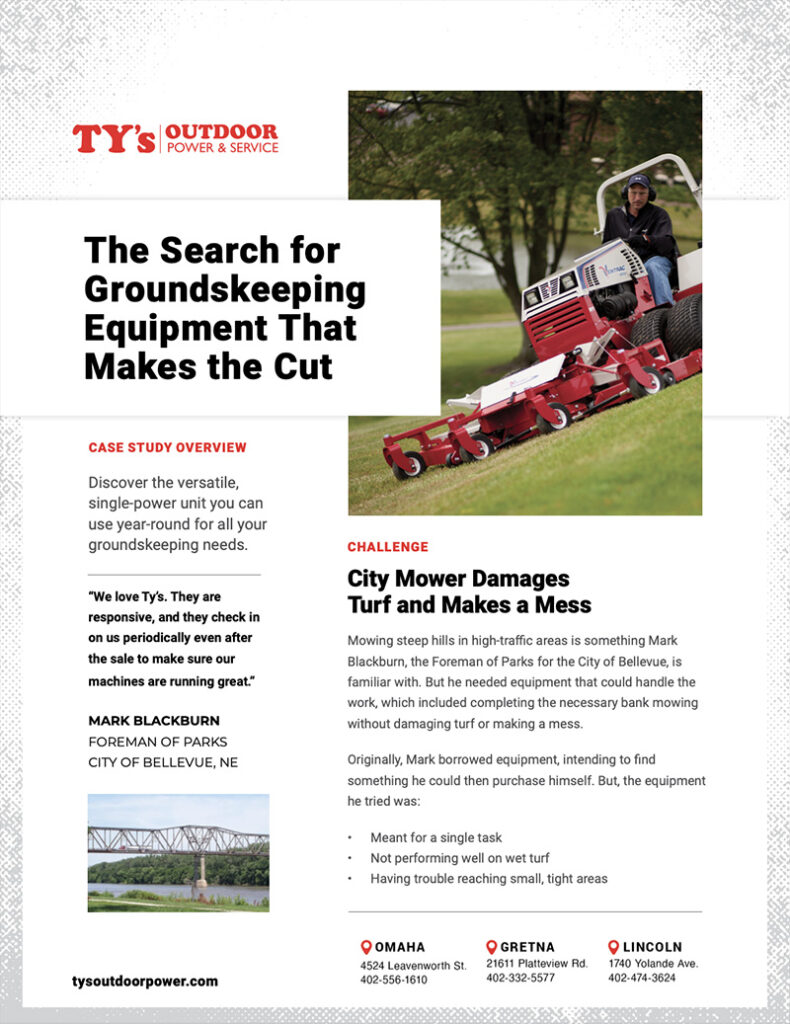If you want a lush, healthy lawn in the spring, it’s not too late to prepare your lawn and equipment for the winter.
Ty’s Top 6 Fall Lawn Care Tips for November
Fall is not just a time for enjoying the beautiful foliage and crisp weather; it’s also the perfect time to prepare your lawn for the cold winter months ahead. By taking a few simple steps now, you can ensure that your lawn stays healthy throughout the winter and emerges in the spring looking lush and vibrant. Here are some essential fall lawn care tips to help you keep your grass in top shape:
Mow Your Lawn Shorter
Why Mow Your Lawn Shorter in the Fall?
- By mowing your lawn shorter in the fall, you prevent the grass blades from matting down and trapping moisture, which can lead to fungal diseases such as snow mold.
- A shorter lawn also helps prevent rodents and pests from finding shelter in tall grass during the winter months.
- Cutting the grass shorter allows more sunlight to reach the soil, promoting healthy grass growth and reducing the risk of dead patches come springtime.
The Correct Lawn Height for Fall:
- Set your lawn mower at a lower height than you typically would during the growing season. However, avoid cutting the grass too short, as this can stress the grass and make it more susceptible to winter damage.
- Aim for a mowing height of around 2 to 2.5 inches for cool-season grasses such as Kentucky bluegrass or tall fescue.
- Mow more frequently during the fall to maintain a proper mowing height and keep your lawn looking neat and healthy.
By mowing your lawn shorter in the fall, you’re taking an important step towards a healthy and vibrant lawn come springtime.
Remove Excess Thatch
Excess thatch prevents essential nutrients, water, and air from reaching the deep roots of your grass. It also provides a favorable environment for pests and diseases.
Detecting Excess Thatch:
- Take a garden rake and run it through your lawn. If you notice a layer of brown, spongy material that is thicker than half an inch, your lawn has excess thatch.
Removing Excess Thatch:
- Use a power rake or a dethatching rake to remove the excess thatch from your lawn. These tools have sharp blades that penetrate the grass and remove the thatch layer.
- Rake through your lawn in a back-and-forth motion, focusing on the areas with the thickest thatch.
- Collect the removed thatch using a rake or a lawn bag. Dispose of it properly.
After removing the excess thatch, you can also consider aerating your lawn to further improve its health. Lawn aeration helps loosen compacted soil and improves water and air circulation.
By properly removing excess thatch, you promote healthy grass growth, prevent pest and disease issues, and ensure a greener, lusher lawn in the spring.
Mulch Your Leaves
Using a mulching blade on your lawn mower to mulch the leaves on your lawn can provide several benefits for your lawn’s health.
Why Mulch Your Leaves:
- Mulched leaves act as a natural source of organic matter, which adds valuable nutrients back into the soil. These nutrients are essential for the growth and development of healthy roots for your grass.
- Mulching leaves also helps retain moisture in the soil, preventing it from drying out during the winter months.
Why Mulching is Better Than Raking:
- Raking leaves can be time-consuming and labor-intensive. Mulching, on the other hand, is a quicker and more efficient way to deal with fallen leaves.
- When leaves are mulched, they are finely chopped into smaller pieces, which allows them to break down faster and easily decompose into the soil.
- Mulched leaves are a natural, organic mulch! They provide a protective layer that insulates your lawn from the harsh winter weather, acting as a natural barrier against temperature fluctuations and frost.
Using your mower to mulch your leaves, with a mulching blade, is an ideal way to nourish your soil, retain moisture, save time, and promote healthy grass growth in the spring. So, grab your mulching blade and let nature work its magic!
Attack Weeds
Fall is the ideal time to tackle weeds in your lawn before they have a chance to take hold and become a nuisance in the spring.
Attack Your Weeds:
- Start by identifying the types of weeds present in your lawn. Different weeds require different treatment methods, so it’s important to know what you’re dealing with.
- For broadleaf weeds such as dandelions and clovers, consider using a post-emergent herbicide specifically designed to target these types of weeds.
- For grassy weeds such as crabgrass or foxtail, pre-emergent herbicides are more effective. These herbicides create a barrier that prevents weed seeds from germinating.
- Apply the herbicide according to the instructions on the package, ensuring it is evenly distributed across your lawn.
- Apply the pre-emergent herbicide before the first frost or when soil temperatures are between 50-55 degrees Fahrenheit.
Following these steps in the fall will help you get a head start on controlling weeds and ensure a healthier and greener lawn come springtime.
Drain Irrigation Lines
Draining your in-ground sprinkler system is an essential step in preparing your lawn for fall and winter. This simple task helps prevent costly damage to your irrigation system and ensures that it will be in good working order when you need it again in the spring.
By taking the time to properly drain your irrigation lines, you can avoid potential damage and ensure that your system is ready to go when warmer weather arrives. It’s a simple step that can save you time, money, and headaches in the long run.
Winterize and properly store your equipment
Proper winterization and storage of your lawn mower and other outdoor power equipment ensures a smooth and easy start-up in the spring. Take these five steps this month:
- Clean and inspect: Before storing your equipment, clean off any dirt, grass clippings, or debris that may have accumulated. This will prevent rust and corrosion. Additionally, inspect the blades, belts, and other components for any signs of damage or wear. Replace or repair as necessary.
- Empty the fuel tank: Storing equipment with fuel in the tank can lead to clogs and fuel system damage. Either run the engine until it’s out of fuel or use a fuel stabilizer to prevent degradation.
- Change the oil and spark plugs: Fresh oil will prevent contaminants from corroding the engine during the winter months. Similarly, installing new spark plugs will ensure a smooth start-up in the spring.
- Protect against rust: Apply a light coating of oil or rust inhibitor to metal parts to prevent rusting. This is especially important for lawn mower blades and other cutting tools.
- Store in a dry location: Find a dry, well-ventilated area to store your equipment. Avoid leaving them outside where they can be damaged by snow or moisture.
By taking the time to winterize and store your lawn equipment properly, you’ll ensure that it’s in good shape for the upcoming spring season. Remember, a little effort now can go a long way in maintaining healthy grass and a well-kept lawn.
End-of-season service on your lawn care equipment is just a click away.
End-of-season service on your lawn care equipment is just a click away! As the colder weather rolls in, it’s crucial to take the right steps to ensure a healthy lawn in the spring.
No time to DIY? Schedule your service with Ty’s Outdoor Power! We’ll pick it up, fix it up, and drop it off back home before you can say “Winter’s coming.”


